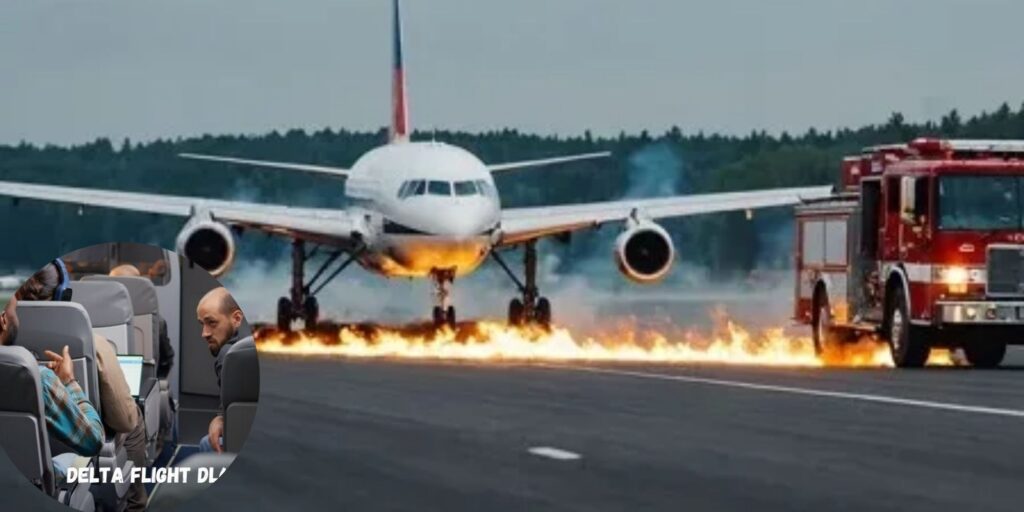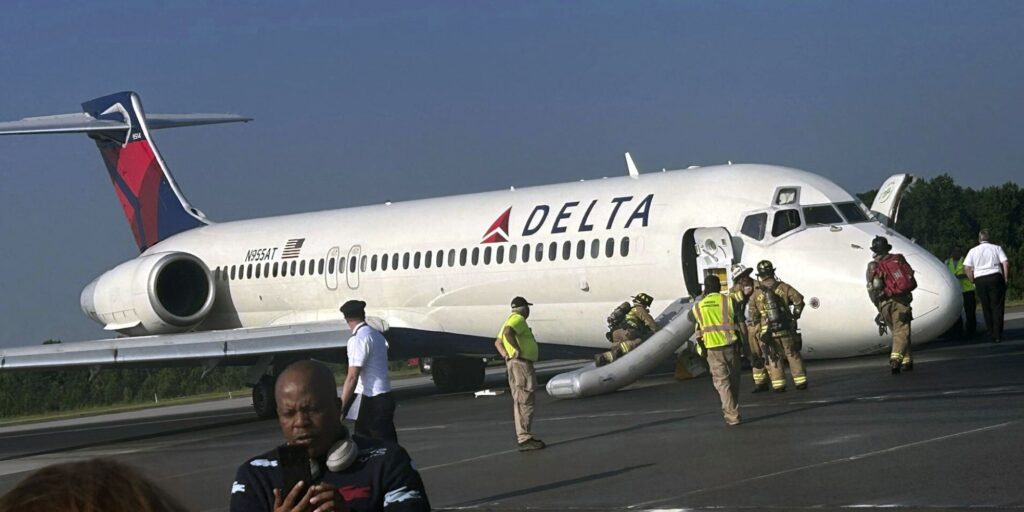On March 15, 2024, Delta Flight DL67 experienced a sudden and dramatic emergency situation, one that sent ripples across the aviation industry and attracted substantial media coverage worldwide. This flight, operating a long-haul route from Rome, Italy, to Atlanta, Georgia, was forced to make an unplanned emergency landing at Shannon Airport in Ireland after an engine alert and mechanical issue arose mid-flight. Below, we’ll delve into what happened, examining everything from the cause of the emergency to the passenger reactions and the industry-wide changes that resulted.
In this comprehensive breakdown, we’ll take a close look at the protocols, crew response, and safety measures that turned a potentially dangerous situation into a controlled emergency. Let’s explore what went wrong on #DL67Adventures and what the industry has learned from this high-stakes scenario.
Delta Flight DL67: Incident Overview
The situation unfolded during the early hours of the flight, shortly after Delta Flight DL67 had entered French airspace. The aircraft, a reliable Boeing 767-400ER, encountered technical problems. The crew detected an engine alert, signaling a potential mechanical issue in one of the engines.
Quick Facts
| Detail | Information |
|---|---|
| Flight Number | Delta Flight DL67 |
| Departure | Rome, Italy (FCO) |
| Destination | Atlanta, Georgia (ATL) |
| Aircraft | Boeing 767-400ER |
| Emergency Landing Location | Shannon Airport, Ireland (SNN) |
| Date | March 15, 2024 |
Incident Summary: The alert initially pointed to a mechanical problem that the flight crew quickly determined needed immediate attention. After communicating with Delta’s operational control, the pilot decided to divert the aircraft to Shannon Airport, known for its robust emergency facilities and quick response teams.
Flight Route and Destination
Delta Flight DL67 is a major transatlantic route operated by Delta Airlines, connecting Rome and Atlanta. This route serves thousands of passengers annually, making it a crucial link for Delta’s international operations.
- Route Details: Rome (Fiumicino) → Paris → French Airspace → Shannon Airport (emergency landing) → Atlanta (original destination)
- Flight Duration: Normally, this route takes approximately 10-11 hours.
Initial Signs of Trouble Onboard
The first sign of trouble came with a warning light that alerted the cockpit crew to an issue with one of the engines. Passengers reported feeling vibrations, which were later attributed to the engine malfunction.
Passenger Reactions
One passenger recalled the scene:
“At first, it was just a slight vibration, but then the captain came over the intercom and calmly explained that we were experiencing technical difficulties.”
This transparent communication was crucial in keeping passengers informed, minimizing panic and enabling the cabin crew to prepare for an emergency landing.
Causes of Delta Flight DL67’s Emergency
The exact cause of Delta Flight DL67’s emergency landing was tied to a mechanical fault in the engine. Initial investigations revealed that a sensor misreading had triggered the engine alert, prompting the crew to take proactive safety measures. Delta Airlines conducted an internal review and collaborated with aviation authorities to determine the underlying cause of the incident.
Mechanical Issues or Just Bad Luck?
Aircraft engines undergo regular checks, and the Delta Airlines fleet is meticulously maintained. However, the high-stress environment of transatlantic flights can occasionally lead to unexpected wear, even on well-maintained engines.
Investigation Findings and Conclusions
Following the incident, an investigation was carried out by the European Aviation Safety Agency (EASA) in conjunction with Delta’s engineering team. Here’s what was found:
- Primary Cause: A faulty engine sensor, which led to a shutdown protocol in mid-air.
- Secondary Factors: High engine usage and wear on specific parts, which have since been replaced across the fleet.
These findings led to regulatory advisories for similar aircraft models and enhancements in sensor maintenance protocols.
Crew Response and Communication
The flight crew’s response to the emergency was nothing short of exemplary. The pilot and co-pilot followed Delta Airlines’ strict emergency protocols and took quick action to manage the situation, ensuring passenger safety.
Emergency Protocols Followed
- Engine Shut-Down: Following the sensor alert, the crew shut down the affected engine as per safety procedures.
- Re-routing to Shannon Airport: Due to its proximity and emergency preparedness, Shannon Airport was selected as the landing site.
- Calm Communication: Passengers were briefed, which helped to minimize panic and ensure a smooth emergency landing.
Communication with Passengers
The crew communicated regularly with passengers, providing updates on the situation and next steps. This transparent approach was critical in keeping the atmosphere calm and controlled.
Emergency Landing at Shannon Airport

As Delta Flight DL67 approached Shannon Airport, the airport’s emergency response teams sprang into action. The coordination between Shannon Airport’s ground staff and the Delta crew ensured a swift and safe landing.
Why Shannon Airport?
Shannon Airport is well-regarded for its emergency response capabilities and is often used by transatlantic flights during emergencies due to its strategic location and support infrastructure.
- Ground Crew Preparedness: Firefighters, paramedics, and emergency personnel were stationed on the runway, ready to assist.
- Runway Clearance: The runway was cleared of all traffic to allow a smooth landing for Delta Flight DL67.
- Evacuation Protocol: Passengers were safely deboarded, and the aircraft was inspected.
Passenger Reactions and Experiences
The incident left a lasting emotional impact on many passengers, yet they praised the professionalism displayed by the Delta Airlines crew and Shannon Airport staff. Passengers shared that the crew’s communication helped them remain calm.
First-Hand Accounts
Here are some insights from passengers:
- “The flight attendants kept us updated. I was scared but felt safe knowing they were prepared.”
- “The emergency landing was handled so smoothly, it felt like a normal landing.”
Emotional Impact: Many passengers expressed feelings of relief and gratitude following the emergency landing. Some stated they felt anxious about flying again, while others praised Delta’s safety measures.
Impact and Aftermath on Delta Airlines’ Operations
Delta Airlines took immediate steps to address both the specific technical fault and broader operational safety.
Operational Changes
- Fleet-Wide Sensor Check: Delta grounded its Boeing 767 fleet briefly to inspect engine sensors across its transatlantic aircraft.
- Crew Training Enhancements: Emergency preparedness and in-flight communication training were updated to reinforce passenger management during emergencies.
Safety Improvements and Policy Changes
To prevent a recurrence, Delta introduced new maintenance protocols and mandatory sensor inspections before long-haul flights. These changes represent Delta Airlines’ strong commitment to safety and operational excellence.
Public and Media Response
The incident drew significant media coverage, with news outlets reporting on the details of the emergency landing, as well as the passenger experience. The coverage highlighted Delta’s transparent response and the safety-first approach that won praise from aviation experts.
Delta Airlines’ Commitment to Safety
Delta’s CEO issued a statement following the incident:
“The safety of our passengers and crew is our highest priority. We are committed to continuously improving our safety protocols.”
Lessons Learned from Delta Flight DL67 Emergency
The Delta Flight DL67 incident has become a case study in emergency preparedness and crew response within the aviation industry.
Analyzing Emergency Protocols
This incident has underscored the importance of maintaining robust emergency protocols, with a focus on crew training and passenger communication.
Training Enhancements for Airline Personnel
Delta has since implemented additional training modules, including:
- In-depth emergency simulations: Preparing crew members for mid-air incidents.
- Communication tactics: Ensuring that crew can keep passengers calm and informed.
The Importance of Aviation Emergency Preparedness
Delta Flight DL67 is a reminder that no matter how sophisticated aircraft technology becomes, preparedness is key. Both crew members and passengers benefit from knowing what to do during an aviation emergency.
Role of Crew and Passengers
Preparedness involves both the crew and passengers. The crew’s quick, calm response paired with the passengers’ adherence to instructions helped to mitigate potential dangers.
Aircraft Maintenance and Safety Measures
In response to the incident, regulatory bodies, including the Federal Aviation Administration (FAA), have reinforced the importance of sensor checks and routine inspections to uphold aviation safety standards.
Conclusion
Delta Flight DL67’s emergency landing is a testament to the importance of preparedness, the effectiveness of emergency protocols, and Delta Airlines’ dedication to passenger safety. Through quick thinking and a commitment to safety protocols, Delta turned a frightening experience into a controlled, safe landing. This incident serves as an important lesson for the aviation industry as a whole, illustrating how proper planning, training, and equipment maintenance can make all the difference.
Frequently Asked Questions
Why did Delta make an emergency landing?
Emergency landings by Delta can occur due to various reasons including mechanical issues, medical emergencies, or severe weather conditions. Each incident is unique and requires pilots to follow specific safety protocols.
What happens when a plane has to make an emergency landing?
The flight crew follows established emergency procedures, communicates with air traffic control to find the nearest suitable airport, and prepares passengers for landing. Ground emergency services are alerted and standing by.
What is the emergency situation in flight?
Emergency situations can include mechanical failures, medical emergencies, severe turbulence, cabin depressurization, or weather-related issues. Flight crews are extensively trained to handle various types of emergencies.
Delta emergency landing / Delta incident today?
For the most current information about specific Delta incidents, please check Delta Air Lines’ official website or news sources, as my information may not be up to date.
Delta flight emergency / Delta flight incident?
Delta flight emergencies are handled according to strict safety protocols. The airline’s pilots and crew are trained to manage various emergency scenarios while prioritizing passenger safety.
Delta flight struck by lightning?
Modern aircraft are designed to withstand lightning strikes with built-in protection systems. When struck, planes undergo thorough inspections before returning to service, even if no immediate damage is apparent.
Delta plane issues?
Common aircraft issues can range from minor mechanical problems to more serious technical malfunctions. Delta maintains rigorous maintenance schedules to prevent and address potential issues.
Delta Boeing incident / Boeing emergency landing?
Boeing aircraft incidents are thoroughly investigated by aviation authorities and manufacturers. Each incident leads to safety reviews and potential improvements in aircraft design or operational procedures.

Brook with 5 years in celebrity styling. Transforms A-list looks into wearable trends.
Expert in red carpet glamour and everyday chic for the stars.





